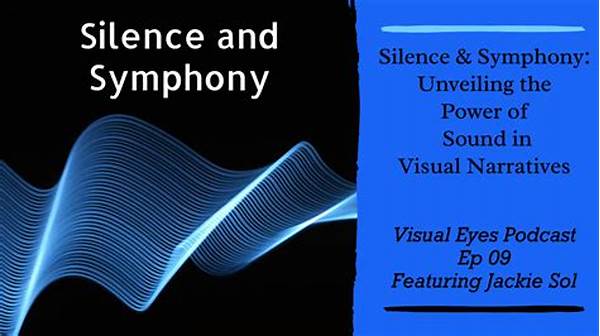Sound is an intangible but powerful element of storytelling. It’s the heartbeat of a narrative, capable of giving life to a story in ways that visuals alone cannot achieve. The power of sound in narratives is akin to an unseen character, guiding emotions and anchoring scenes. Whether it’s the subtle hum of a distant crowd, the chilling silence of an empty room, or the triumphant crescendo of a score, sound frames our perception and drives our emotional engagement.
Read Now : Motivational Pop Song Anthems
The Impact of Sound in Storytelling
Think about movies or radio dramas where sound plays a crucial role. The power of sound in narratives is undeniable when you consider how it shapes your experience. It’s more than just background noise—it’s the invisible glue that binds together the visual elements, script, and performances to create a cohesive whole. In a high-octane action thriller, those gut-pounding sound effects keep you at the edge of your seat, while in a serene, pastoral film, the gentle rustling of leaves sets a calming tone. Sound’s ability to transport us to different settings, times, and emotions highlights how essential it is to crafting memorable stories. Without the strategic use of sound, narratives would lose their spark, their edge, and their impact. It fills the gaps, tugs at heartstrings, and paints a fuller picture.
Embracing the Soundscape
1. Sound layers blend like a good mixtape, amping up the narrative vibe.
2. Silent pauses are dramatic gold, legit leaving audiences hanging.
3. Extreme sound shifts keep us guessing, reinforcing narrative twists.
4. Ambient noise immerses us deeper, man, it’s like we’re literally there.
5. Character themes, dude, turn characters into unforgettable legends.
Sound as a Narrative Tool
The power of sound in narratives is comparable to an artist’s palette, providing countless possibilities to enrich a story. Using sound to foreshadow events or signify a character’s inner turmoil adds depth and anticipation. Sound bridges gaps that words may not quite cover, enabling storytellers to delve into abstract feelings and subliminal cues. Moreover, sound can define a cultural context or historical setting faster than lengthy expositions, making it an efficient tool for immersive storytelling. This invisibility cloaks the narrative in a rich tapestry of emotion and meaning, subtly leading the audience through the twists and turns of the plot. From audio diaries to film soundtracks, sound remains an unsung hero in narrative construction.
Unleashing Narrative Potential Through Sound
1. Soundscapes paint invisible scenes, significantly impacting story depth.
2. Music scores evoke emotions, chiseling memorable narrative moments.
3. The absence of sound amplifies the weight of silence, dude, it’s intense.
4. Diegetic sounds ground stories in realism, making them way relatable.
5. Sound morphs regular scenes into iconic moments; it’s all in the ear.
Read Now : Memorable Love Song Lyrics
6. Soundtracks become cultural touchstones, defining narrative eras.
7. Experimenting with sound fosters narrative innovation, trust me.
8. Sonic motifs herald character entries, like audio calling cards.
9. Audio cues dictate pace, amping up tension or dialing it down.
10. Nature sounds create a backdrop, keeping narratives natural and fluid.
Crafting Stories with Sonic Flair
Now, let’s dig into how sound, with its silent might, sneaks into the crevices of narrative, shaping perceptions and driving action. The power of sound in narratives isn’t in-your-face, but its presence is a game-changer. It maps emotional landscapes, opening channels to unseen places. Think of it like this: sound is the pulse, asserting narrative rhythms and revealing hidden layers. Consider the iconic horror movie soundscapes—they exploit silence and sudden crashes to make us jump out of our comfy seats. It’s an unseen force, turning mundane settings into ominous, edge-of-the-seat rides. Or take a sweeping epic where an orchestral score swells, making an ordinary journey seem grand and heroic.
Though often flying under the radar, the power of sound in narratives is a linchpin, grounding stories in sensory truth. Whether it’s the crackling of a fireplace in a cozy scene or the eerie hum of a UFO in a sci-fi thriller, the auditory elements breathe life into the narrative. The sound has the uncanny ability to cross language barriers, reaching the core of human experience. They amplify emotions, making tensions tenser, joys more jubilant, and sorrows deeper. In essence, sound creates a bond between the narrative and audience, bridging gaps and building connections in a shared auditory experience.
Sound Strategy in Storytelling
At its core, the power of sound in narratives rests on its strategic prowess. A nifty trick up any storyteller’s sleeve, sound provides texture and depth. Using sound strategically can pivot a dull scene into suspenseful territory or uplift a heartfelt moment into tear-jerking greatness. Consider how natural soundscapes transport us into different realms. A single bird call or distant thunder can set the scene in seconds. Sound acts like a narrative rudder, steering stories towards their intended emotional shores. With each tap, thud, murmur, and harmony, stories vibrate with authentic energy that simple dialogue can’t encapsulate.
Essentially, sound delivers narrations that transcend words, offering an immersive ticket into the universe of the story, man. Forget mere scripts; dive into worlds sculpted by sound’s rich textures. Whether you’re lost in a podcast engrossed or enraptured by a film’s undertones, appreciate the enigmatic power of sound in narratives. The auditory landscape is the unspoken champion of storytelling, silently guiding the direction and flavor of each tale. When sound sings, stories soar, allowing narratives to unfold in lavish audial color, contrasts, and dimensions. The sonic narrative is not caught by the eyes but is felt deeply in the ears and heart, forever echoing within the listener’s mind.
